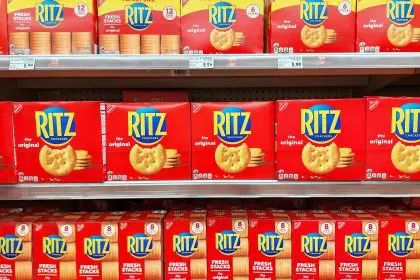A devastating food safety crisis has emerged as federal health authorities announce an urgent recall of popular chicken fettuccine alfredo products sold at major retailers nationwide. The recall, affecting three specific frozen meal varieties available at Kroger and Walmart stores, comes after a deadly Listeria outbreak that has tragically resulted in three deaths and one pregnancy loss since August 2024.
The gravity of this situation cannot be overstated. Health officials have confirmed that 17 people across 13 states have fallen ill from consuming these contaminated ready-to-eat meals, marking one of the most serious foodborne illness outbreaks in recent memory. The outbreak has prompted immediate action from federal agencies, who have classified this recall at the highest risk level possible.
The 3 recalled products putting families at risk
Manufactured by FreshRealm, the recalled items represent some of the most popular frozen meal options available at America’s largest grocery chains. Consumers must immediately check their refrigerators and freezers for these specific products, which have been distributed nationwide through major retail networks.
The first product under recall is the 32.8-ounce tray labeled “Marketside Grilled Chicken Alfredo with Fettuccine,” carrying best-by dates of June 27, 2025, or earlier. This larger family-sized portion has been a staple in many households, making its contamination particularly concerning for families who regularly purchase bulk frozen meals.
The second recalled item is the 12.3-ounce tray of “Marketside Grilled Chicken Alfredo with Fettuccine and Broccoli,” with best-by dates of June 26, 2025, or prior. This smaller portion size, often marketed as a convenient single-serving option, has been popular among busy professionals and students seeking quick meal solutions.
The third dangerous product is the 12.5-ounce “Home Chef Heat & Eat Chicken Fettuccine Alfredo” tray, with best-by dates of June 19, 2025, or earlier. This brand, known for its meal kit services, has expanded into ready-to-eat options that have gained significant market share in recent years.
All three products bear establishment numbers “EST. P-50784,” “EST. P-47770,” or “EST. P-47718,” which consumers can use to identify potentially contaminated items in their possession.
Timeline of a deadly outbreak
The outbreak’s timeline reveals a troubling pattern that has unfolded over nearly a year. The first reported cases emerged in August 2024, suggesting that contaminated products may have been circulating in the food supply chain for months before detection. The most recent confirmed infection occurred in May 2025, indicating that the contamination problem persisted despite initial awareness of potential issues.
Federal investigators made the critical connection between these products and the outbreak after discovering the same strain of Listeria in a routine sample of FreshRealm’s chicken fettuccine alfredo during standard food safety testing. This discovery prompted immediate collaboration between multiple federal agencies to trace the source and extent of the contamination.
The geographical spread of confirmed cases across 13 states demonstrates the far-reaching impact of this outbreak, though health officials have not yet disclosed which specific states have reported illnesses. This nationwide distribution pattern reflects the extensive retail network through which these products were sold, potentially affecting thousands of households across America.
Understanding the Listeria threat
Listeria monocytogenes represents one of the most dangerous foodborne pathogens, capable of causing severe illness and death, particularly among vulnerable populations. Unlike many other bacteria, Listeria can continue growing even at refrigerator temperatures, making contaminated frozen and refrigerated foods especially hazardous.
The bacteria poses the greatest threat to pregnant women, seniors aged 65 and older, and individuals with compromised immune systems. For pregnant women, Listeria infection can result in miscarriage, stillbirth, premature delivery, or life-threatening infection of the newborn. The outbreak’s confirmation of one pregnancy loss underscores this tragic reality.
Healthy adults and children can also develop serious illness from Listeria exposure, though they typically have better outcomes with proper medical treatment. However, the bacteria’s ability to cross the blood-brain barrier can lead to severe complications including meningitis and brain abscesses in any infected individual.
Recognizing the warning signs
Symptoms of Listeria infection typically develop within two weeks of consuming contaminated food, though they can appear as early as the same day or as late as 70 days after exposure. The variability in symptom onset makes it challenging for both patients and healthcare providers to immediately connect illness with specific food consumption.
Early symptoms often mimic common flu-like illness, including fever, muscle aches, and fatigue. However, as the infection progresses, more serious neurological symptoms can develop, including severe headache, stiff neck, confusion, loss of balance, and seizures. These advanced symptoms require immediate emergency medical attention.
Pregnant women may experience only mild flu-like symptoms, but the infection can have devastating consequences for the developing fetus. Any pregnant woman who has consumed recalled products should contact their healthcare provider immediately, even if they feel well.
Immediate action steps for consumers
Anyone who has purchased these recalled products must take immediate action to protect their health and that of their family members. The most critical step is to avoid consuming any recalled items, regardless of whether they appear, smell, or taste normal. Listeria contamination cannot be detected through sensory evaluation.
Consumers should carefully dispose of recalled products by placing them in sealed bags before throwing them away, preventing potential cross-contamination of other foods or surfaces. Alternatively, many retailers are accepting returns of recalled products for full refunds, even without receipts, given the serious nature of this health threat.
Thorough cleaning and sanitization of any surfaces, utensils, or containers that may have come into contact with recalled products is essential. This includes refrigerator shelves, microwave interiors, and any dishes used to serve these meals.
The broader implications for food safety
This outbreak highlights ongoing challenges in the food safety system, particularly regarding ready-to-eat meals that consumers expect to be safe without additional cooking. The involvement of major retailers like Kroger and Walmart demonstrates how contamination at the manufacturing level can quickly spread through extensive distribution networks.
The recall also underscores the importance of robust food safety testing and surveillance systems. The detection of contamination through routine sampling likely prevented even more cases of illness, though questions remain about how long contaminated products were available before discovery.
Consumer awareness and education play crucial roles in preventing foodborne illness. Regular checking of recall notices, proper food storage, and recognition of symptoms can help minimize the impact of contamination events when they occur.
Moving forward with caution
As investigations continue, consumers should remain vigilant about food safety practices and stay informed about recall notices. The tragic loss of life associated with this outbreak serves as a stark reminder of the importance of food safety measures throughout the supply chain.
Federal agencies continue working to determine the exact source of contamination and ensure that proper corrective measures are implemented to prevent future outbreaks. The cooperation between manufacturers, retailers, and health authorities will be crucial in rebuilding consumer confidence in these popular convenience foods.
This outbreak represents a significant public health emergency that demands serious attention from consumers, healthcare providers, and food industry professionals alike. The swift action taken to issue recalls and public warnings reflects the commitment to protecting public health, but individual vigilance remains the best defense against foodborne illness.

















